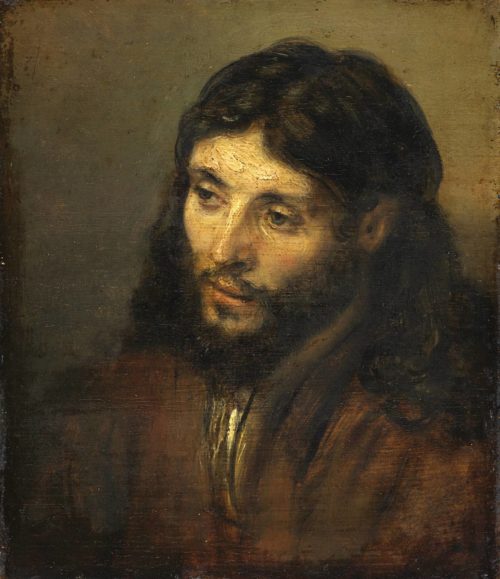
By Anne W. Semmes
“No one knows what Christ looked like,” began Greenwich’s Page Knox, PhD, in her recent talk “Images of Christ in Art Throughout the Centuries” in the Parish Hall of Christ Church before an audience of 140 people. Knox teaches art history at Columbia University while giving talks for the Metropolitan Museum of Art. “But one of the most exciting images of Christ is in your backyard,” Knox continued, “is on exhibit at the Yale University Art Gallery – the ‘Healing of the Paralytic.’ What you’re seeing is Christ actually healing a bedridden man who literally gets out of bed and walks with the bed.”
The primitive fresco image she showed dates to 234 AD, found in 1921 in one of the oldest surviving Christian churches in the world, the Dura-Europos church in Syria. “So, this is very early pre-Constantine, when you don’t see many images of Christ until about 315 AD when Constantine declares himself to be Christian, because Christians are being persecuted and there isn’t much opportunity for them to create imagery.”
Knox proceeded to walk us through the chosen art giving the historic backdrop across the ages to the contemporary art of Salvador Dali. As of the mid third century she told, “You start to see the evolution of types, the different depictions of Christ, as found in the catacombs of Rome of a beardless Christ as the ‘Good Shepherd.’ But as Christianity didn’t become the official religion of Rome until the Justinian period of the sixth century, “Christ often resembles Apollo…The bearded figure emerges in about the fourth century.”
“Christianity takes over,” she adds, “They take ancient Roman temples and convert them to basilicas…to churches.” Mosaics now depict “Christ sitting in a throne with a beard, with the large halo behind him and the cross in the background.”
‘Depending on where you live and where you worship and where you come from, she told, “Christ tends to take on traits of that culture or that ethnicity.” She jumps to China and shows a silk fragment. “It’s very much damaged, but it’s been reconstructed here to show you a painting of Christ from the ninth century, the Tang Dynasty, a time in which the Church of the East was established in China. And we don’t expect to see Christ looking like someone from China in that way.”
“Has anybody been to St. Catherine’s Monastery in Mount Sinai in Egypt?” she asked. “It is the repository of all of these exquisite and major icons of Christ from the Byzantine era. It’s a very unique place. It was established by Constantine’s mother Helena, where the site of the burning bush was believed to be. She established this monastery thinking it to be a very critical site, not only in terms of its religious history, but also for the Silk Road.”

“And then we make our way to the West,” she continued, “You start to see again this idea of Christ in majesty as a very prominent theme in the early medieval era. So, whether you’re in England in the Anglo-Saxon period, or you’re in the Ottonian Empire in Germany, you constantly see this image of Christ full figure with a mandala with the four Apostles around him, often with rulers kneeling in front of the Christ.”
Come the Renaissance, she told, when “the Greek texts are being rediscovered, and there’s a new awareness in the classical world.” There came the “desire to think more about Christ as human. You start to see in the imagery actual scenes from the life of Christ, with Giotto often considered to be the beginning of Renaissance painting. “You see here an image of the lamentation…the death of Christ, the love of a mother for her son.”
Christ has become “a means by which artists explore ideas about perspective, about naturalism, about conveying the human form. So, Christ on the cross is a very spiritual, very important religious symbol, but it also offers artists an opportunity to think about the human body…You start to see the use of perspective entering into the working methods of Renaissance artists.” She cited the Convent in San Marco in Florence where, “each monk in the monastery has its own cell decorated by Fra Angelico” with pictures of the story of the life of Christ. And it is a very powerful place.”
“People often go to the Sistine Chapel in Rome looking for images of Christ,” she told. “They look up on the ceiling and they see Genesis. They look at the Last Judgment which does have an image of Christ. But the real stories of the life of Christ are on the walls…the lifecycle of Moses on one side and the life of Christ on the other…painted by that great second generation of [Renaissance] artists…all painting these wonderful scenes.”
Knox cited Leonardo de Vinci as exemplifying the high Renaissance in his painting of the “Last Supper” in the Santa Maria della Grazie church in Milan; “It is quite a marvelous demonstration of all of the things that he’s learned from all of those other artists as well as in his own career to create this image of Christ…It’s a very human drama…Its one of the most iconic images of Christ.”

Seeing Jan van Eyck’s Ghent Altarpiece in Northern Europe was “a life altering experience,” told Knox. “The St. Bavo Cathedral has had this marvelous masterpiece for 600 year…Having the image of Christ, or God in the center was one of the first to appear in what we call the Northern Renaissance. Van Eyck was said to have the eye of a telescope and a microscope.”
In Holland, she shared, “Catholics are not allowed to worship publicly. They are allowed to worship privately in their homes.” Thus, Johannes Vermeer had painted “very genre scenes. Milkmaid women looking out of windows…that speaks to these private chapels in homes of Catholics where they can actually worship.” Vermeer’s image of “Christ in the House of Mary and Martha,” showed those “milkmaids” with Christ.
Knox ended her talk with images from her “favorite artist” Henri Matisse who she called “not necessarily a very religious man.” Suffering from cancer at the end of his life in the care of nuns, “He said to these nuns, how can I thank you?” They told him, “We have no place of worship.” Matisse told them, “I will design one for you” that became the Matisse Chapel of the Rosary in Vence, France. “It’s one of the most spiritual, most marvelous places in the world if you want to have a spiritual encounter with contemporary art.
“He designed the altarpiece, and the crucifix. And if you go to the Vatican, you can see a cast of that crucifix in the Vatican Museum’s Collection of Modern and Contemporary Art.” It was while working on his chapel Knox shared that he said, “So I believe in God, yes, and I am working.” Knox then concluded, “I think it’s a real testament in the fact that images of Christ can appear in many different sizes, in so many different ways, over many different eras, many different periods, and that there’s a power in that image that is universal.”





